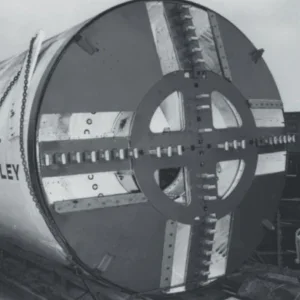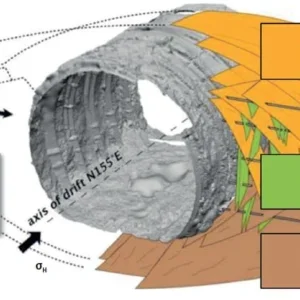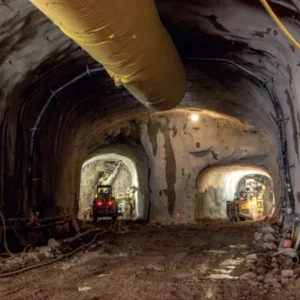For a long time melbourne has relied on one key link between the city’s central business district (CBD) and the western suburbs, the West Gate Bridge over the Yarra River.
Technical director, West Gate Tunnel Authority, Shane D’Rozario, explains that the bridge was constructed in the 1970s. “It’s not an easy crossing because the West Gate Bridge is a big structure and it is quite tall to allow containers ships to cross the Yarra River and reach the harbour,” he adds. “Consequently to build an additional bridge crossing of the Yarra faces numerous significant constraints.”
The West Gate Tunnel will provide an alternative to the West Gate Bridge.
D’Rozario says: “One of the main benefits of having a tunnel in this area is to go underneath a residential area in the western suburbs, which have been affected for decades by a high volume of traffic, including heavy trucks.
“The commitment of the tunnel is direct links to the Port of Melbourne and some additional ramps to the West Gate Freeway, leading to the Port of Melbourne to allow the transit of trucks with dangerous loads that can’t go in a tunnel.”
The project value is AUD 6.7bn (USD 5bn).
The project’s construction is underway and is scheduled to be completed in 2022. There are two other key sections to the project concerning upgrading the existing freeways to connect to the new tunnel.
The first of two TBMs will arrive in January and the second one is due in the coming months after. The first TBM will be launched in early 2019 while the second one will be launched a few months after. They will be launched from the northern portal site in the suburb of Footscray in Melbourne. Both machines will be launched from the same box, side by side with approximately 6m of separation.
“The finish of the drive of the first tunnel will be mid to late 2020; the second tunnel has a similar timeline but the drive will start a couple of months later than the first tunnel in 2019 and it will finish around 2020,” says D’Rozario. “We expect to finish the second tunnel earlier than the first one as the second tunnel is shorter than the first one.”
The project is a public private partnership (PPP) between the Victorian Government and Transurban. The design and construction was put to a competitive tender by the PPP, and CPB Contractors and John Holland Joint Venture (CPBJH JV) was the successful party. They are building the project for Transurban and the Victorian Government.
CPBJH JV then subcontracted the design work to Aurecon and Jacobs.
Construction method
Two road tunnels are being built – the citybound tunnel is 2.8km long, and the outbound tunnel, 4km long. In early concept designs the tunnels were of a similar length however, after extensive community consultation, the outbound (west bound) tunnel was made longer to move the portal ventilation structure further away from homes to minimise visual, noise and construction impacts.
“The launch (northern) and retrieval (southern) portals, which are approximately 450m long, will be constructed using the cut and cover method. The northern portal will be temporarily supported using secant piles and the southern portals will be supported using rock support techniques. We will excavate the two bored tunnel sections, using the segmentally lined TBM method,” says Andrew Shepherd, tunnel zone manager from CPBJH joint venture.
“The project has two Herrenknecht EPBMs with an excavation diameter of 15.61m for the tunnels.”
Shepherd explains that geological investigations have been carried out through boreholes. “We had around 120 geotechnical boreholes along the alignment to map the geology of the drive,” he says. “These investigations have been done by both CPBJH JV in the post tender phase and the client Transurban in the pre-tender phase.”
“We decided to use an EPBM as the geology that we have to go through is predominantly residual basaltic clays with sections of weak to solid rock and alluvial silty clays, but there is a section which is primarily in the longer drive, which is hard basalt up to 250 MPa. The EPBMs for the project have been designed to manage all of these conditions, incorporating advanced ground conditioning systems and a high specification of wear protection.
“In the first 500m, we also have a very low cover section of the drive which is excavated through residual clays with overlying sandy clays. With such a large machine, excavating in closed EPB mode is the safest method as it is imperative to maintain good control of the surface settlement.
Lining
The precast tunnel lining composition is 10 + 0 with a trapezoidal key, with 20 circumferential bolts. The lining has an internal diameter of 14.1m and is 500mm thick with a 40mm universal taper.
“The segments are 2.40m long which are the longest segments in the world,” says Shepherd. “There were significant efficiencies in reducing the numbers of cast segments. The alignment radius and TBM size allowed for the large length to be adopted.
“The segments are mainly steel fibre reinforced concrete segments. We have some steel bar reinforcement in the low cover area and at the cross passages as well.”
The pre-cast facility is based in Benalla, in Victoria’s northeast. The moulds and carousel systems will be manufactured by French company CBE while the segments are manufactured by the CPBJH. Shepherd adds that they can store roughly 50 rings on site while the others will be stored at the pre-cast facility.
Ground Engineering
“At the northern portal, where the TBMs will launch, we have a ground treatment block which comprises of 6.5m of Cutter Soil Mixing (CSM) treated ground over Shepherd. “So, it’s 13m of ground treatment when we start. This treatment is required for the launch to allow the TBM to break into the ground and establish the face pressure as it’s a soft eye launch. We will use a rubber seal ring manufactured by Mitsubishi for the launch.
He adds: “The site is situated in an industrial area with nearby residential areas. We will be tunnelling 24 hours per day, seven days a week so the site has to adhere to noise management levels. We have to tunnel under a residential area but we will be in primarily soft ground so ground borne noise and vibration impacts will be minimised.”
The spoil will be transferred through the tunnel via a continuous conveyor. On the surface, a 600m-long elevated conveyor will transfer the material to a spoil bin and then excavators will load the spoil into trucks. Two conveyors, one for each TBM, will be used. The capacity of each of the conveyors is 2,500 tph. The conveyors are being supplied by Marti Technik in Switzerland.
Groundwater Challenge
Shepherd explains, “The tunnel will be sealed with a single EPDM 33mm gasket supplied by Datwyler. The water pressure at the tunnel axis level is at the deepest point. It will be a maximum of 3.5bar.
“We won’t go under the river but we are within 200m of it when we launch the TBM.” Shepherd said that to avoid groundwater movement in the soft ground areas during construction, groundwater will be controlled by operating the TBM in EPB closed mode or EPB compressed air mode. In addition, recharge systems have been setup along the alignment to control any groundwater movement.’
Hyperbaric Interventions
“We are going through areas with mixed faces of basalt, sand and clay,” says Shepherd. “There is an approximately 1km area where we expect hyperbaric interventions. Thus, we are training our tunnelling workers and engineers for this operation. We expect pressures ranging from 1.8 to 3 bar.”
Ventilation
Ventilation during TBM tunnel is through 2 x 2.1m diameter ventilation ducts with a target to achieve 0.75 metres per second air velocity through the tunnel.
Other Challenges
While the TBM is tunnelling, approximately 600m behind the machine, independent crews will be constructing the road deck and smoke duct structures and constructing the cross passages.
The road deck structure comprises of an in-situ concrete corbels which support 2.4m long x 10.5m wide precast road planks. The smoke duct is a similar configuration with in-situ corbels and 2.4m long x 10m wide smoke duct units. The cross passages are every 120m and will be constructed using a single pass jacked box method.







